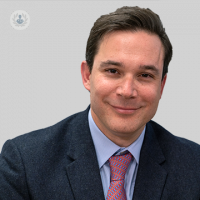Why does my shoulder hurt? The many causes of shoulder pain
Written by:The shoulder is the most flexible joint in the human body with the widest range of motion. It is involved in a great number of everyday activities, including reaching up to cupboards, reaching behind our backs and brushing our hair. Expert orthopaedic surgeon Mr Ioannis Polyzois explains what causes shoulder pain.

Shoulder pain may occur due to tendonitis, muscle tears, osteoarthritis, impingement and several other causes. There are many possibilities due to the complex anatomy of the shoulder.
Essentially, the shoulder is comprised of three bones:
The top of the humerus, which is shaped like a ball, fits into a shallow socket called the glenoid. In your shoulder blade there are strong ligaments and tendons which keep the ball centred in the socket, as well as the rotator cuff muscles, which allow you to lift and rotate your arm. Any pathology or problems with this part of the anatomy may cause pain in the shoulder.
What can cause shoulder pain?
Shoulder pain is an extremely common problem. There are various potential causes.
The most common cause of pain on the outside of the shoulder is a rotator cuff problem. There are four rotator cuff muscles essential to moving the shoulder (the supraspinatus, infraspinatus, subscapularis and teres minor).
There are three main types of rotator cuff problems:
- Tendonitis (inflammation of the tendons)
- Bursitis – inflammation of the bursa – fluid-filled sacs that protect and lubricate the tendons which connect the shoulder muscles to your upper arm bone respectively. Bursitis usually accompanies tendonitis.
- Rotator cuff tears – these occur when the tendons of the rotator cuff separate from the bone.
These problems usually cause painful symptoms when performing activities such as reaching overhead, or during sports such as skiing.
In addition, there can be deep, aching shoulder pain from a rotator cuff problem, which tends to be worse or flare up at night. It is therefore not uncommon for people who suffer from rotator cuff tendonitis or a rotator cuff tear to be unable to sleep on the affected shoulder or have difficulty falling asleep on that side.
Rotator cuff problems can also present with a limited active range of movement; therefore the shoulder often feels stiff. If a doctor lifts the arm, the shoulder will move normally.
Other causes of shoulder pain include:
- Frozen shoulder – a very common diagnosis also termed adhesive capsulitis. Frozen shoulder leads to stiffness of the joint and constant pain and discomfort with most day-to-day activities and movements. With frozen shoulder, there is a loss of passive range of motion, which a doctor cannot improve when moving the arm, as well as loss of active range of movement (the patient moving the arm on their own).
- Calcific tendonitis – calcific tendonitis is a condition where calcium crystals are deposited within the supraspinatus tendon. This condition typically causes very severe and sometime excruciating shoulder pain, which is worse at night and exacerbated by movement.
- Biceps tendonitis – pain at the front of the shoulder is commonly related to inflammation of the biceps tendon sheath. Patients usually develop pain at the front of the shoulder and this moves down over the biceps. This is worse with lifting, carrying and over-the-head activities. This can sometimes cause a clicking sound when the arm is rotated.
- Biceps tendon rupture – more significant, a biceps tendon rupture occurs during an injury. Sometimes, a sudden pop can be heard, along with worsening pain, bruising and swelling, and formation of a lump higher up the arm near the humerus, or a lump just above the elbow. That differentiates between a proximal and distal biceps tendon rupture.
- SLAP tear – anterior to posterior tear of the labrum. This specific type of labral tear in the shoulder can happen with a simple fall on an outstretched hand or in athletes who throw overarm or manual workers who are involved in heavy, repetitive activities. These symptoms can include deep shoulder pain, a catching sensation and popping sound with movement.
- Shoulder arthritis – a person may describe a deep shoulder pain at the front of the shoulder, along with stiffness. There is generally loss of active and passive range of motion and can sometimes be confused with a frozen shoulder in the absence of an X-ray.
- AC joint arthritis – can cause bone spurs with wearing away of the smooth cartilage. The pain is felt on top of the shoulder and the patient usually complains of pain upon direct palpation of the AC joint from above.
- AC separation/dislocation – people who develop an AC joint separation/dislocation usually have a history of trauma caused by falling onto that shoulder. Depending on the severity of the ligaments that are involved, a bump may form above the shoulder due to the separation of the shoulder blade from the collar bone.
- Distal clavicle osteolysis – osteolysis is a fairly uncommon condition, which causes sharp pain at the collar bone. It is most commonly seen in weightlifters and people who repeatedly lift or carry heavy objects over the shoulder.
- Shoulder instability – instability is a common problem that involves a loose joint. This can be caused by an injury, dislocation to the shoulder, or from overuse. Shoulders that feel unstable feel that they may pop out of the joint. Some people have loose ligaments, which result in a chronically unstable shoulder and can also be called multi-directional instability, which is usually the case in young athletic or sporty women. Patients often describe a dead arm feeling and have an excessive range of motion in the shoulder.
- Dislocation of the shoulder – an injury that occurs when the arm bone becomes disconnected from the shoulder blade. If someone dislocates their shoulder, normal ligaments may be damaged and the shoulder has a tendency to feel unstable or pop out of the joint again.
- Shoulder impingement – a very common cause of shoulder pain, which often occurs after repeated overhead motions such as swimming. All the tendons in the bursa get pinched between the bones of the shoulder and makes it painful to move the arm. Various activities with overhead motions, reaching the back, or lying on that side may all worsen the symptoms
- Fractures/trauma, e.g. a fractured collar bone, fractured humerus, or a fractured shoulder blade.
- Neck pain can sometimes radiate to the shoulder and be confused or mimic shoulder pain. A full neurological examination needs to be undertaken with appropriate scans.
- Heart attack – left arm or shoulder pain can be a symptom of an impending heart attack or heart disease.
Learn more about shoulder pain treatment here
For a consultation with Mr Polyzois, visit his Top Doctors profile.



